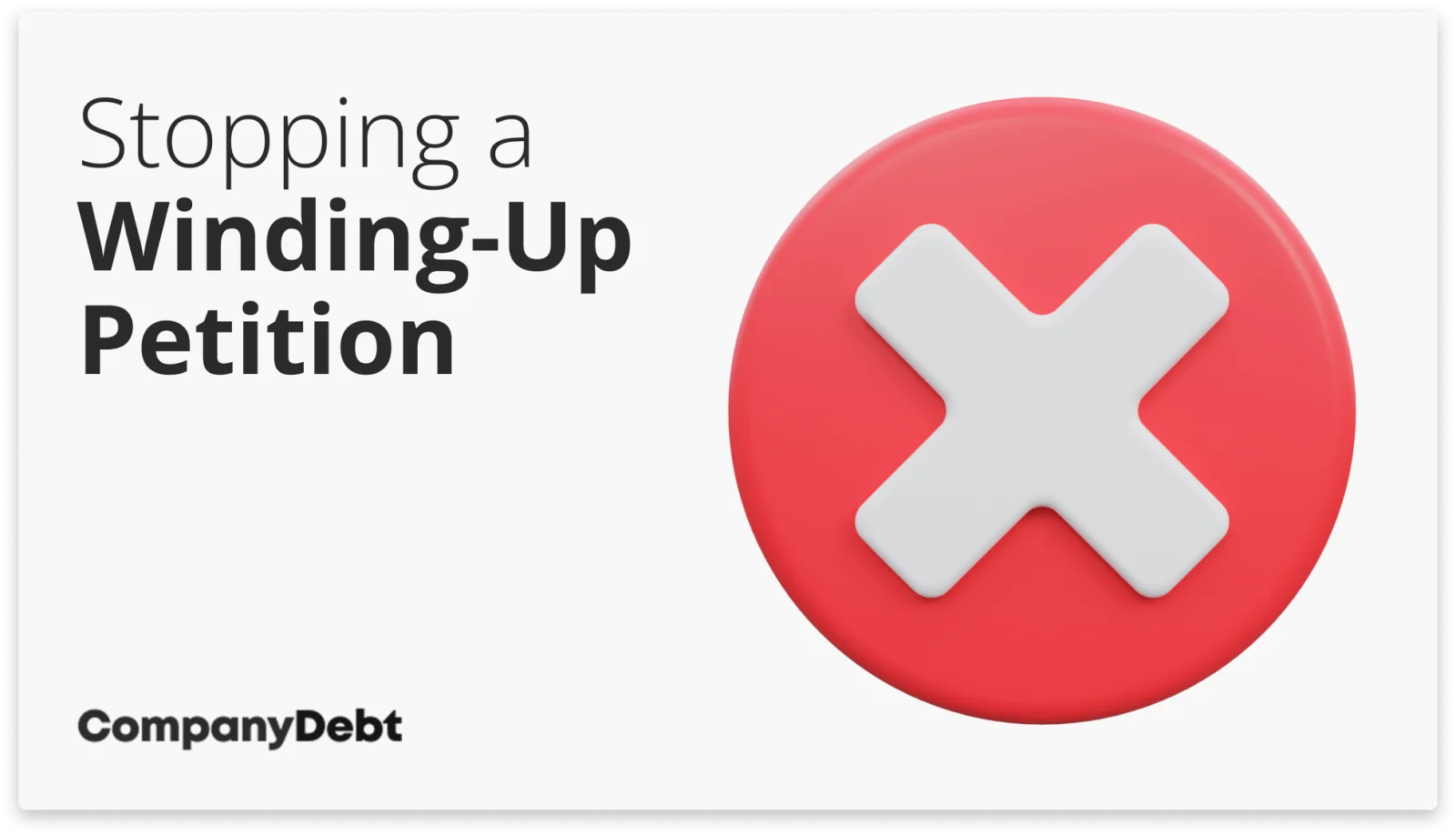What is a Winding up Petition?
- What is a Winding up Petition?
- What to do if You’ve Received a Winding up Petition?
- Can a Winding up Petition be Stopped?
- Winding up Petitions are Publically Advertised in the Gazette
- What’s the Cost of a Winding Up Petition?
- Can You Stop a Winding up Petition if it’s already been Advertised?
- What Happens if the Court Grants a Winding Up Order?
- Can a Winding up Order be Reversed once Issued?
- Summary
- Help with a Winding Up Petition
What is a Winding up Petition?
A winding-up petition (WUP) is a method by which a business creditor, who must be owed over £750, starts the court process to wind up a company for non-payment of debts. It’s the direct precursor to compulsory liquidation.
It can only be issued if the debtor has received and ignored a statutory demand served at least 21 days ago or the creditor has a court judgment (CCJ) against the debtor.
Once a WUP is issued, the case will be heard in court, where both parties can present evidence. Generally, WUPs are heard in either the High Court of Justice in London (for companies registered in England and Wales and for larger cases) or in local courts for smaller amounts.
Based on this, a judge will make a ruling, and if the debtor company can’t pay, it is immediately put into compulsory liquidation.

What to do if You’ve Received a Winding up Petition?
If you’re a company director facing a WUP, it’s vital to seek expert advice immediately from either an expert in company law or a licensed insolvency practitioner (IP) such as ourselves. After the petition is served, you have just seven days before your it is advertised in a journal of public record known as the Gazette. Banks keep a close eye on Gazette advertisements and will freeze your bank accounts as soon as they spot it.
Consulting an insolvency practitioner like ourselves can provide you with the guidance needed to prevent the liquidation of your company, but you don’t have much time.
Can a Winding up Petition be Stopped?
Yes, a winding-up petition can be stopped. This typically involves either settling the debt with the creditor who filed the petition or challenging the petition in court if there are grounds to do so. Prompt action is essential to prevent the petition from leading to compulsory winding-up.
Settle or Negotiate the Debt
The quickest way to stop a winding-up petition is to pay the debt owed to the creditor in full. If paying the entire amount is not possible, the company can attempt to negotiate a settlement agreement with the creditor. This may involve proposing a repayment plan or offering a lump sum that is less than the full debt amount. If the creditor agrees to the settlement, they will withdraw the winding-up petition.
Put the Company into Administration
Entering administration provides a legal moratorium that prevents creditors from taking further action against the company, including winding-up proceedings. A licensed insolvency practitioner is appointed as the administrator to manage the company’s affairs and attempt to rescue the business or achieve a better outcome for creditors than a liquidation.
Company Voluntary Arrangement (CVA)
A CVA is a formal agreement between the company and its creditors to repay all or part of the debts over a fixed period. If approved by 75% of creditors, a CVA binds all unsecured creditors, including those who voted against it. A successful CVA proposal will result in the dismissal of any outstanding winding-up petitions.
Opt for Creditors’ Voluntary Liquidation (CVL)
If the company is insolvent and rescue is not viable, directors can initiate a CVL by calling a meeting of shareholders and creditors. This allows for an orderly liquidation process where an insolvency practitioner liquidates the company’s assets and distributes the proceeds to creditors. Choosing a CVL over a compulsory liquidation provides more control and may result in a better outcome for all parties.
Dispute the Debt
If the company has a strong legal defense against the debt claimed by the petitioning creditor, it can file evidence and argue its case at a court hearing. Successful disputes will result in the dismissal of the winding-up petition. However, disputing the debt is a high-risk strategy as legal costs can quickly accumulate, and a loss in court may worsen the company’s financial position.
Obtain a Moratorium
The moratorium introduced by the Corporate Insolvency and Governance Act 2020 allows an insolvent but viable company to protect itself from creditor actions, including winding-up petitions. By appointing a licensed insolvency practitioner as a monitor, the company can benefit from a 20 business day initial moratorium period, extendable up to 40 days. During this time, most legal actions are halted, providing breathing space to explore rescue options like refinancing, administration, or a Company Voluntary Arrangement (CVA) without creditor pressure.
Winding up Petitions are Publically Advertised in the Gazette
If you’ve received a winding up petition, you should be aware that these are advertised in the Gazette, which is the official journal of public record. This public advertisement can have serious reputational consequences for the company:
The advertisement clearly states the creditor petitioning for the winding up and the amount of debt owed. This information being openly available could deter potential customers, suppliers or investors from doing business with the company due to concerns over its solvency.
Once advertised, other creditors may use the advertisement as a prompt to also issue legal demands, compounding the company’s financial troubles.
Obtaining a Validation Order After Bank Accounts Have Been Frozen
When a winding-up petition is advertised, it’s common for banks to freeze the company’s accounts to protect the assets within. I
This can significantly disrupt business operations. In such situations, obtaining a validation order from the court is a critical step. This order permits the company to use its bank accounts for specific transactions, ensuring that essential business operations can continue.
A validation order may cover various transactions, including payments into and out of a company’s bank account, property transfers, and contracts.
To obtain a validation order, the company must demonstrate to the court that the transactions in question are crucial for the business and won’t disadvantage the creditors. It’s a complex legal process and typically requires the assistance of an insolvency practitioner or legal advisor. Directors should act swiftly to apply for this order to minimise operational disruptions and protect the company’s interests.
What’s the Cost of a Winding Up Petition?
The financial implications of initiating a winding-up petition are considerable and should be carefully considered. The typical costs include
- A court fee of £1,880
- A petition deposit of £1,600
- Process server fee of £75-£100
- Company House search fee of £2
- Advertisement fee of £79.40 plus VAT
Therefore, the total cost of a winding up petition can be significant, and it is essential to factor this in before taking any action.
Can You Stop a Winding up Petition if it’s already been Advertised?
Once a winding-up petition has been publically advertised in the Gazette, stopping it becomes significantly more challenging. Realistically, you must take swift action within days of receiving the petition to avoid liquidation. However, there is still hope if the court hearing has not yet occurred. You should contact an insolvency practitioner immediately to explore options.

What Happens if the Court Grants a Winding Up Order?
A Winding Up Order is a court order that follows a Winding Up Petition and signifies the commencement of a company’s liquidation process. The order marks the transition from the petition phase to actual liquidation, where an Official Receiver or appointed liquidator takes control of the company, ceases its operations, liquidates its assets, and pays off creditors.
This process concludes with the formal dissolution of the company at Companies House.
Can a Winding up Order be Reversed once Issued?
Once issued, a Winding Up Order is generally considered final and cannot be easily reversed. However, in exceptional circumstances, it may be possible to have the order rescinded or stayed, although this is rare and typically requires prompt and compelling action.
To attempt to reverse a Winding Up Order, the company or its directors must apply to the court. The grounds for such an application usually involve demonstrating that the order was made based on incorrect information or that the company has since secured the funds to pay its debts. Alternatively, the court may consider rescinding the order if the company can reach an agreement with its creditors, such as through a Company Voluntary Arrangement (CVA).
Summary
Below, we have listed do’s and don’ts for company directors that have received a winding up petition.
Dos:
- Do seek insolvency advice as soon as possible. It is essential to understand the implications of the winding up petition and have a plan for how to respond.
- Do consider whether the company has a viable future. If the company is able to trade out of its difficulties, it may be worth considering alternative options to winding up, such as a company voluntary arrangement or administration.
- If you plan to allow the winding-up petition to go ahead uninhibited, do cooperate with the insolvency practitioner appointed to manage the winding-up process. It is important to provide them with all relevant information and to follow their instructions.
Don’ts:
- Don’t try to dispose of company assets or transfer them to another entity in an attempt to avoid the winding-up process. This is illegal and could result in personal liability for the directors.
- Don’t continue to trade if the company is unable to pay its debts as they fall due. This could result in further debts being incurred and could increase the potential for personal liability for the directors.
- Don’t ignore the winding up petition or the insolvency process. It is important to take action and engage with the process in order to minimise the potential impact on the company and its stakeholders.
Help with a Winding Up Petition
Facing a winding-up petition can be daunting, but you don’t have to navigate it alone. Our experienced insolvency practitioners at Company Debt are here to assist you every step of the way.
Whether you need advice, support, or guidance on restraining the advertisement of a winding-up petition or managing the entire process, we are ready to help.
Contact us today:
- Phone: 0800 074 6757
- Email: info@companydebt.com
- Live Chat: Available on our website
Don’t delay; let us help you protect your company’s future.
FAQs
What Happens at a Winding-up Petition Hearing?
At the hearing, the creditor presents its case for why the winding-up petition should be granted, and the company can respond and present its case. The court will consider the evidence and arguments presented by both parties and decide whether to give the petition and issue a winding-up order.
Can a Winding-Up Petition be Contested?
Yes, a company can contest the petition by demonstrating its ability to pay off debts or by negotiating terms with the petitioner. Legal advice is strongly recommended in such instances.
What Happens if the Court Approves the Petition?
If the court finds the petition legitimate, a winding-up order is issued, and an Official Receiver is appointed to oversee the liquidation process. Assets are sold, and proceeds are used to repay creditors.
Are Directors Personally Liable for Company Debts?
Generally, directors are not personally liable unless they have provided personal guarantees or have been involved in wrongful or fraudulent trading.
How Can One Avoid a Winding-Up Petition?
Preventative measures include maintaining transparent financial records and open communication with creditors. If financial difficulty arises, consult professional advisers promptly to explore alternative solutions like a Company Voluntary Arrangement (CVA).







